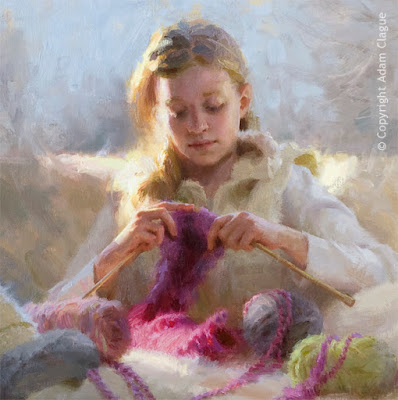
It's one thing to paint something to look like that something. It's another thing entirely to paint that something dynamically, in a way that draws your viewer's attention from across the room.
When you just can't make your painting of that apple look like the apple, be encouraged that there is a maximum of just 5 things that could be wrong—drawing, value, edge, temperature and/or color (See "5 Reasons Your Painting Doesn't Look Like Your Subject").
However, like I mentioned last time, there is another set of issues beyond these 5 that may keep your painting from being as strong as it could be. Does your picture lack "punch"? Do the elements in your picture seem lopsided? Is it unclear where the viewer should look? These are usually issues with composition.
To avoid composition problems, remember "4 Principles for Powerful Picture-Making":
- Center of Interest or Focal Point
- Placement
- Value Pattern
- Line
1. Center of Interest

Your center of interest (or "focal point") is the thing you want to convey the most. To decide what your center of interest should be, ask yourself, "what is the most important thing I want to communicate through this picture?" You can certainly communicate multiple things in the same painting. But when you do, it's a good idea to emphasize your most important statement and make your other statements subordinate. Otherwise, your viewer can feel visually overwhelmed and be confused as to where he is supposed to look.
In a room of shouting people, no single voice is heard.
The remaining 3 Principles for Powerful Picture-Making can be used to make your center of interest more powerful and compelling…
2. Placement
Do
the elements in your pictures ever feel lopsided or otherwise awkward?
Next time, plan the placement of elements beforehand by sketching small
thumbnails in pencil. This allows you to move the elements around until
they feel "right."
Good placement can be very subjective, but here are a few rules of thumb that can help (these are certainly not absolutes):
Good placement can be very subjective, but here are a few rules of thumb that can help (these are certainly not absolutes):
- Avoid placing your center of interest exactly in the center.
- Placing your center of interest higher than the canvas's center is often more appealing than placing it lower.
- The
further you place your center of interest from the center of your
canvas, the more likely it will be that you'll need an opposing
secondary element to balance it. This can help avoid lopsided pictures.
3. Value Pattern
Value pattern can give your picture that compelling "punch" to draw a viewer's attention from across the room. Value pattern is the arrangement of basic shapes of darks and lights. I often spend a great deal of time planning my value patterns by making thumbnail sketches like this:
If a value pattern is strong as a thumbnail, it will usually be strong in the final painting, too.
When I plan a value pattern, I consider these rules of thumb (again, these are not absolutes):
- Allow the area of highest value contrast to be on or near your center of interest. This is one of the most powerful pulls to attract your viewer's eye.
- Don't allow your dark shapes and light shapes to occupy the same amount of surface area. This can look static.
- As much as possible, connect areas of similar value into one continuous shape. This almost always makes a composition stronger.
4. Line
Lines—both actual and implied—are powerful devices that can be used to lead your viewer on a fun journey through your painting and toward your center of interest.
In this painting, notice how the lines of the yarn, seat back, cushions, and other elements lead the eye through the piece. Although the lines take the viewer on a meandering stroll through the picture, they eventually lead back to the center of interest—the girl's face and hands.

Dig Deeper With the
Online Video Course
(Click image to view full-size)
This blog lesson only scratches the surface of composition. In my online video course, I’ve dedicated two entire units to its study! You’ll learn how to draw your viewers from across the room with dynamic compositional techniques.
Access to the course will become available for purchase on October 7, 2019, but you can start the course today for FREE! For more information, please click the button below.
|
Many people ask me how they can paint more loosely and have more interesting brushwork. Becoming a looser painter was a long journey for me, but in the next lesson, I'll share How This Perfectionist Learned to Paint More Loosely.
See you there!
—Adam













